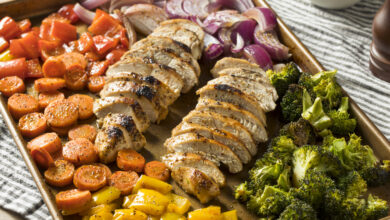A
A
A
Though cholesterol has gotten a bad reputation over the years, the human body can’t do without it. Cholesterol is a sterol, which means it’s a type of lipid. It’s necessary to help the body make hormones, cell membranes and vitamin D, which is created when sunlight strikes cholesterol in the skin. There are several types of cholesterol, but the type of cholesterol that’s problematic is LDL, or low level density lipoprotein. This is the type of cholesterol that combines with other chemicals to clog the lining of blood vessels with plaque. This can lead to such problems as cardiovascular disease. LDL is the type of cholesterol that doctors recommend to be lowered if it gets too high. How can that be done?
Tips on Lowering Cholesterol: Lose Weight
A person doesn’t even need to be obese to have elevated cholesterol. Even a few pounds over their ideal weight can lead to elevated cholesterol, so weight loss is vital. This means eating healthy food and cutting down greatly on fizzy, sugary sodas and candies, cakes and cookies chock full of nuts, chocolate, nougat, cream and other fillings. Swap them out, as much as possible, for fruits or even candies that don’t have a lot of fat. Exercise also helps with weight loss and enhances overall fitness. This can be as simple as walking 15 minutes a day, working in the garden or even doing housework.
Read More »
Stop Smoking There’s no bodily function that smoking doesn’t damage, and cholesterol levels are one of them. Not only will quitting smoking lower the LDL levels, but it raises the levels of HDL, which is the “good” cholesterol. HDL is responsible for transporting LDL to the liver, where it is processed. The health improvements seen after a person quits smoking often occur immediately. They include lower blood pressure and heart rate, improved lung and circulatory function and lower risk of heart disease.
Drink in Moderation
Moderate alcohol consumption has been shown to raise the levels of HDL, but heavy alcohol use leads to a wealth of problems, including cardiovascular disease. Moderation means a drink a day for women and men over 65 and two drinks a day for younger men.
Eat Foods Good for the Heart
Foods that are heart-healthy include those rich in soluble fiber, which slows down the body’s absorption of cholesterol. This type of fiber is found in apples, pears, oatmeal and Brussels sprouts.
People who aren’t familiar with whey protein should think of adding it to their diet. Whey is that leftover liquid that’s produced when a person makes homemade Greek yogurt or cheese. It’s been shown to lower both blood pressure and levels of cholesterol.
Other foods to add to the diet include those abundant in omega-3 fatty acids. Though these foods, which include fatty, cold-water fish such as salmon, don’t directly lower LDL cholesterol, they’re still good for the heart.
Avoid Transfats
Transfats were popular because they gave food a delicious mouthfeel, but their propensity to raise bad cholesterol levels makes them problematic. They are still found in margarines and baked desserts, but as of 2021 they’ll be banned by order of the Food and Drug Administration.
Cut Down on Saturated Fats
Saturated fats are found in full-fat dairy, deep fried foods, processed foods and red meat. They raise the levels of all types of cholesterol, and reducing them can also reduce levels of bad cholesterol.
What to Do If These Tips Don’t Work
For some people, high cholesterol levels run in their family, and there are those with an inherited type of high cholesterol called familial hypercholesterolemia. These people can be treated through having LDL cholesterol removed from their blood via a machine. People with less drastic forms of high cholesterol can control their levels through drugs called statins combined with changes in their diet and lifestyle.






